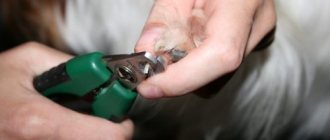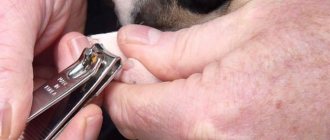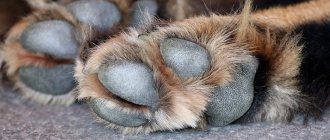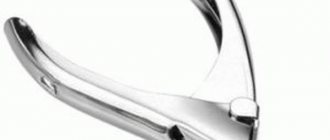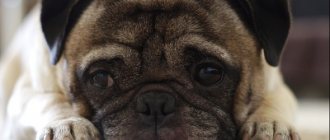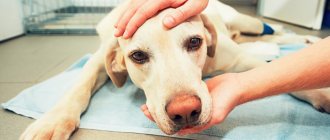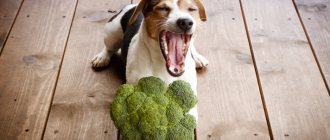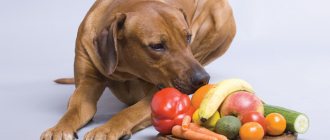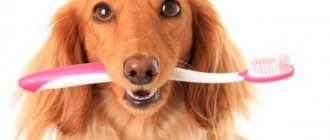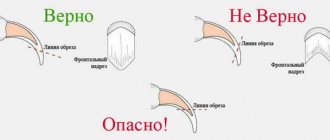Every dog breeder faces the question: how to trim a dog’s nails? Most often, people go to a veterinary clinic to carry out this procedure, however, if you follow all the rules, you can easily cut your pet’s nails at home. Many dog owners go to the veterinarian for the first time, and then ask to be shown how to trim them so that they can do it themselves at home. One visit to a specialist is enough to have an idea of how to do it yourself.
Why is it necessary to trim off the overgrown part of the claw?
Life itself presents a fact: trimming nails is necessary, otherwise dogs will experience serious discomfort. Due to overgrown claws, the animal becomes downright clumsy:
- When walking, it is difficult for him to dig in hard soil.
- At home, the dog clings to soft materials - carpets and rugs.
- On tile, laminate and other types of smooth floors, the poor guy slips his paws, loses confidence and becomes restless.
- An excessively long nail process causes physical pain to the dog - when pressure is applied while walking, the hard part peels off from the flesh of the pad and the wounds become infected.
Overgrown claws cause discomfort to both the animal and the owner.
How do you know when it's time to get your claws done? If a clicking sound is heard when the animal walks on a hard, smooth floor, then their length is clearly outside the normal range. In the normal state, the chitinous plate goes around the soft pad, but does not go beyond its edge.
In nature, animals sharpen their claws themselves. Walking on asphalt and digging holes in hard ground achieves some of the same effect. In addition, animals (this also applies to pets) gnaw off the edges of the nail plates that interfere with them; they act intuitively as they begin to experience discomfort. But all these measures are not enough, so the owner must monitor the situation.
For what?
Is it necessary to trim a dog’s nails, because many dogs grind their nails down themselves during long walks on the asphalt. But not all dogs have their nails worn down when walking on a hard surface. And the fifth claws do not touch the ground at all and generally cannot grind off on their own.
At first glance, overgrown nails may not seem like such a big deal, but there are still many important reasons why they should be trimmed.
Why cut:
- Long claws can curl inward and, growing even larger, dig into the animal’s fingertips, causing severe pain.
- Overgrown claws tend to crack and break. And, if the claw gets too caught on something, it can break anywhere, even near the base.
- Due to long nails, the dog cannot place its paw straight and keep it in a ball. Toes become twisted or curved unnaturally, which is especially harmful for puppies, as this can lead to deformation of joints and ligaments.
- The animal's balance is disturbed. The dog may skid to the side when running, and on a smooth surface it may slip and fall.
- Overgrown claws can be dangerous not only for the dog, but also for its owners. The dog may accidentally injure the owner with them or tear his clothes.
- For show dogs, overgrown claws are a serious fault for which their score in the ring is greatly reduced.
Therefore, if you do not want unnecessary problems for either your pet or yourself, you need to monitor the condition of its claws and trim them regularly.
Consequences of owner laziness:
Preparation for pruning
Dogs do not like human intervention in this matter. When claws are cut off, the animal often panics and behaves extremely restlessly. It’s not for nothing that veterinarians advise accustoming puppies to the procedure from childhood - psychological attunement eliminates the pet’s nervousness during the “execution.”
If you are dealing with an already grown animal, monitor the dog shortly before the procedure. Play often, and massage your paw pads while you play. Teach your pet not to be frightened by touching its claws. Meanwhile, carefully examine the structure of the claws and their condition. This is especially important when the claw and the flesh of the pad are equally dark - the border between them is faintly visible.
Explore the range of pruning tools in advance. It is strictly forbidden to use:
- household scissors (they split the animal’s thick claw, rather than making an even cut);
- ordinary nail clippers - they are designed for a flat human nail. In dogs, the shape is round, semi-cylindrical, and the plate itself is much thicker.
Why the problem cannot be ignored
Many owners come to terms with their pet's phobia and stop cutting their nails. But sooner or later, long nails will cause discomfort and pain, but by that time, cutting will become a “mission impossible.”
To trim the nails of a dog that is hysterically afraid, you have to resort to using sedatives. This is a justifiable measure, since the stress caused by nail trimming is more harmful than the side effects of sedatives.
To avoid problems with grooming, the dog must be accustomed to the procedure from puppyhood.
Tools
There are several types of pruning tools. Manufacturers make sure that any dog can find a device that can solve the problem painlessly and without the risk of injuring the subungual flesh.
Guillotine
Trimming your dog's nails with a guillotine is a quick and easy process.
Tool Features:
- cutting occurs sharply when the upper and lower cutters close - a claw is placed between them before pressing;
- the blade is not straight, but slightly rounded (so that the cut has an arched shape without sharp corners);
- ease of use;
- recommended if nails are of medium length;
- replaceable parts.
The tool is suitable for small dogs and puppies. Their claws are relatively soft and thin without large bends. A guillotine will not work if they are too short or very long; only a perfectly sharp device is suitable for the job.
If the metal is dull, it means the blade is dull, and working with it will lead to either injury or delamination of the edge of the claw.
Scissor nail clipper
Scissor nail clipper - an inexpensive and easy-to-use tool
Peculiarities:
- the design is like that of ordinary scissors, the only difference is in the shape - it has the shape of a blade, slightly curved in order to provide a rounded cutting line;
- the cheapest tool in comparison with more “advanced” options;
- requires speed when cutting (combine, press, get a perfectly smooth edge);
- Suitable for both small and large dogs, regardless of age and breed.
With frequent use, cutting surfaces become dull and the metal takes on a dull appearance. Dull scissors should not be used. If you can’t find a good craftsman to sharpen the blades, they are thrown away.
Wire cutters
Trimming nails with clippers
This tool is closer to a professional one. It is often used by professionals who provide dog nail trimming services. Peculiarities:
- act similarly to scissors - due to the overlap of two cutting blades;
- there are long handles, similar to garden pruners, between which a spring element is placed (it helps to open the blades, returning them to an inoperative state);
- Models of different sizes are available for sale, depending on the build of the animal and the type of its claws.
Disposability can be considered a disadvantage. A dull tool is thrown away because the cutting elements cannot be replaced. Otherwise, there is a risk of injury to the animal's pulp, as well as uneven trimming.
How to hold it correctly?
The position of the dog at the time of trimming its nails depends on its size and breed. When trimming the claws of a small dog, the owner most often sits it on his lap and, clasping its body with one hand, performs all the necessary manipulations with the other.
It is better to place a large breed dog on a small raised surface with an anti-slip mat on it. If the dog is very worried, then it is better to sit behind him and start trimming the nails on the front legs, holding the dog by the back and neck.
How to trim nails at home - step-by-step instructions
Before you start trimming, you need to thoroughly study the structure of the animal’s claws, namely:
- where is the pulp located (it contains nerve endings and blood vessels);
- where the cut line should be.
If you have repeatedly played with your dog in advance and examined its nails and pads, you can trim your dog’s nails at home without much difficulty.
When pruning, it is important not to touch the pulp with blood vessels and nerve endings.
During the procedure it is important:
- act relaxed, talk to your pet as if nothing had happened;
- accompany your actions with a playful and affectionate intonation;
- hold your paw tightly, but at the same time without any intention of violent action.
The overgrown nail should be cut midway between the outer edge and the pulp border. This distance is considered optimal.
Hand position:
- the master’s palm should be located under the dog’s paw;
- the thumb is on top and lightly presses on the base of the dog’s phalanges - if the animal is relaxed, its “fingers” will rise slightly;
- Shaggy breeds usually have long hair on their paws. It needs to be bent and held with your thumb - the hair should not obscure visibility.
At this moment, a neat and confident cut of the claw is made.
If you follow all pruning recommendations, the procedure will be quick and painless.
How often?
How often should you trim your dog's nails? Puppies begin to trim their claws very early, around ten days. This is done to prevent the babies from injuring their mother or littermates. As the puppies grow, their nails are trimmed as soon as necessary.
For adult animals, it is recommended to trim their claws about once a month.
The frequency of nail trimming may depend on the following reasons:
- Age of the animal
- His breed: small breeds grow their claws faster,
- Individual characteristics of the dog,
- Conditions for keeping and feeding the pet.
What to do if your dog is injured
Sometimes a dog gets injured during a haircut for the following reasons:
- lack of knowledge about the structure of the claw and the owner’s anxiety;
- lack of practical experience;
- the dog jerked sharply during the process because it was not prepared for the procedure and was under stress.
It is important to immediately disinfect wounds.
For such cases, you need to have on hand:
- disinfectants and hemostatic agents (hydrogen peroxide, iodine, potassium permanganate solution, alum pencil, talc, wheat flour);
- dressing material - cotton swabs or disks, bandage.
If a wound appears, quick treatment will help stop the bleeding and protect the paw pads from infection.
Injectable sedatives
If your dog is aggressive and tries to bite, injectable sedatives may be needed to trim problem nails until desensitization is successful. Nails should not be allowed to grow without trimming or natural wear and tear, so if they are long enough, your veterinarian will need to sedate your dog in order to trim the nails safely.
Physical restraint should not be used if the dog is struggling to bite. This will only make the dog more fearful and aggressive the next time and could potentially hurt the person restraining it.
The injection will calm your dog so that he does not become aggressive during nail trimming, and will also prevent the stress, fear and anxiety he is likely to feel during these events.
Injections do come with risks and costs, but if desensitization is practiced at home, over time you may be able to use oral medications or supplements instead.
As your dog becomes less reactive and aggressive towards nail trimmings, injectable sedatives may not always be necessary. No one should physically force a dog to trim its nails, even if it is muzzled. If he aggressively tries to stop the process by growling, snarling, or attempting to bite, an injectable sedative should be administered or the nail trimming should be stopped. Always look for a veterinarian who uses low-stress treatment methods.
Additional care - dog pedicure
Dogs' nails need to be cared for throughout the pet's life. This is not about worshiping glamorous fashion, but about a vital necessity. Domestic dogs are losing many of the advantages that nature originally endowed them with many centuries ago:
- The way of life is such that there is no need to get food for yourself and use your own claws - which means they are not trained and not sharpened enough.
- Nutrition includes many components characteristic of an urban environment (in nature, such “additives” simply would not exist in dog food).
As a result, dogs' claws become loose, and their structure is often disturbed—proper care will solve the problem. Pedicure accessories will provide the nail plate with an even edge and a smooth surface. You can learn how to do a pedicure yourself, but you shouldn’t forget about professional services.
What you need to have in your arsenal:
- hemostatic powder and hygienic material (cotton pads, clean paper towels or napkins);
- a special file for dogs;
- electric polishing tool - grinder.
When using a grinder, the risk of injury is minimal
Using an electric grinder, you can adjust your claws all year round. Then they do not have time to grow, which means there is no need for a haircut.
An untrained dog is irritated by the vibration and characteristic sound of the device. But this can also be solved. One or two procedures, and the pet will resign itself, making sure there is no reason to worry.
If there is blood
In this case, you need to take potassium permanganate powder and generously sprinkle it on the wound, or you can use any other hemostatic agent. As a rule, after this the bleeding stops almost immediately. When using potassium permanganate, in order to avoid poisoning, which can happen if the pet accidentally licks it off, after stopping the bleeding, it is necessary to remove all remnants of manganese powder from the dog’s fingers and claws, without touching the cut itself.
There is no need to do anything else with the wound, but be prepared for the fact that if the pulp has been damaged, the dog will limp for some time.
If the wound visually looks dangerous, then wrap the paw in a clean towel, apply ice and go to the vet without hesitation.
ATTENTION ! Any injury during nail trimming is a sign that the procedure should be stopped immediately!
Suitable time, frequency of treatments and other tips
In order for both the owner and the dog to feel comfortable, the following recommendations must be taken into account:
- The main recommendation is to involve the dog in the process. Violent actions will not bring the desired effect.
- A play environment is created for the animal, after which the claws are gradually processed.
- While a haircut happens relatively quickly, a pedicure takes much longer. You can’t finish all the work in one session; you’ll have to finish it in two or even three sessions.
- The frequency of pedicures is individual and depends on the condition of the claws - approximately once every 1-2 months. Age, diet, and the presence of diseases in the pet also play a role.
The growth of claws cannot be left to chance - a loving owner will always take care of their condition. Systematic observation of the dog will help determine the nature of the impact and the frequency of procedures. On average, trimming and pedicure takes half an hour, sometimes more. However, these procedures ensure normal nail growth, protect the paw pads and the overall health of the animal.
How to Reduce Your Dog's Stress During Nail Trimming
What to do if your dog is afraid to trim its nails? The process of getting used to cutting is long, but what to do if the nails are already too long?
Alternative ideas:
- Active walking. When a dog walks, runs and jumps a lot, its nails wear down naturally. By the way, too long claws are an indicator of insufficient loads.
- Sawing. Allows you to gradually shorten and “blunt” the claws. For dogs that get active walking, filing may be sufficient (you can do without trimming).
- Special door mats. Mats with a special surface for cleaning paws and grinding down claws are actively sold on international trading platforms. Unfortunately, there are almost no reviews about this “know-how”, so you can evaluate the advantages and disadvantages only after purchase.
If your dog's nails grow quickly, the above methods are almost ineffective. Your task will reduce stress - stop using classic scissors and nail clippers. To accomplish this task, you can train your dog to use a special grinder.
How can I make the procedure more relaxed for my dog?
Before working with your pet, take care of his calm. Remember that your calmness and patience also play a paramount role.
First of all, you need to identify the cause of concern. If the dog begins to get hysterical and break out, then perhaps he has some kind of trauma from childhood associated with his paws. In this case, give your pet a couple of days, more if possible. At this time, grab the paws more often, showing that it is not painful or scary. When the animal gets used to it, start bringing scissors to the paw (do not cut it). When starting the process, prepare some treats. If you trim a claw, give it a treat and praise your pet. As a result of such manipulations, the dog will calmly sit through the entire procedure.
Nails should be trimmed at the correct angle and to a certain point to avoid damaging the paws. Therefore, it is recommended that beginners contact a veterinary clinic or groomer.
Doctors know the right approach without additional manipulations: injections, sedatives, etc. Owners may be asked to be present during the procedure to make the dog feel more comfortable.
Useful tips
To ensure that the procedure does not cause trouble for your pet, you should adhere to the following recommendations:
The need for a haircut is determined by the clicking sound when walking, which appears in dogs with overgrown claws.- It is important to regularly examine your pet’s limbs, paying special attention to the accessory toe. It does not wear off during walking and leads to injuries.
- Choose a sharp nail clipper with well-sharpened blades - this reduces the duration of the procedure and minimizes discomfort from it.
- Before the procedure, the dog is allowed to smell the instrument so that it is convinced that the item does not pose a danger.
- It is good to do a haircut after a bath: at this time the pet is relaxed, and the claws are steamed, making it easier to trim.
- The owner must wash their hands thoroughly before the procedure.
If it is not possible to examine the paw well, it is better to have the trimming done in a clinic or at a groomer, so as not to injure the pet.- Along with the claws, the hair between the toes must be trimmed to avoid the development of fungal diseases, ingrown claws, and changes in gait.
- Scissors for cutting dog horns are purchased only in veterinary stores . This is an ideal device for eliminating growths.
What to trim besides claws
Since your dog has entrusted his paws to you, take the opportunity to trim everything you can. In addition to the claws themselves, it is also necessary to regularly trim the hair between the toes and pads. This must be done no less carefully. Take regular scissors and lightly press down on the pad to spread your fingers apart. Carefully trim the long hair without touching the toes or pads.
This procedure is especially important in winter, when snow freezes on the fur between the toes and gives the dog very unpleasant sensations.
First aid for injuries
Despite full compliance with the rules and compliance with the operating algorithm, even an experienced owner can make a mistake. This can be caused by various circumstances: a sharp sound outside the window, a dull nail clipper, or excessive nervousness of the pet. Don't get upset - it's important to remain calm, apologize to the dog and treat the wound.
Pulp cut
Trimming too short greatly increases the risk of damaging blood vessels. This causes severe pain and excessive bleeding. The main task of the owner in case of pulp injury is to urgently stop the bleeding. In addition, it is necessary to calm your four-legged friend - his reaction will be panic and a desire to run away.
The owner should try to distract the animal, switch its attention to something else - perhaps to a toy or a pre-prepared treat. There is no point in screaming at this moment, as the dog is already scared and in pain. Next you need to treat the wound with hydrogen peroxide. It is not recommended to use alcohol-based solutions - they will only increase the pain and cause a burning sensation.
Antiseptic powder has a good effect. Veterinarians advise having this drug in your pet first aid kit. It is used to treat open wounds and abrasions and copes well with injuries caused during trimming of the nail plate.
Claw detonation
A similar nuisance arises in the case of nervous and uncertain actions of the dog breeder. The dangerous combination of slow compression of the nail cutter along with an unexpected and sharp jerk of the limb during shortening leads to a poor result. Damage to the skin and soft tissues is accompanied by severe pain and fear, and not only from the dog - the owner also experiences nervous shock. However, you should gather your strength and provide first aid to the victim:
Try to keep the animal in place. Don't shout, but be assertive and speak confidently.
Next, you need to bandage the injured limb near the metatarsus with a tourniquet or bandage. It is advisable to lift the paw up to stop the bleeding.
Cold is applied to the damaged surface. You can use an ice pack or frozen food for this.
Open wounds must be treated with lidocaine or novocaine.
Sometimes the damage is very severe, so the tear must be stitched. Only a veterinarian can do this.
When transporting an animal to a veterinary clinic, cold should be applied to the damaged area, but at the same time avoid frostbite of the limb.
Black
Inexperienced owners do not always understand how to cut a black claw, because when cutting them (and dark brown claws) a problem arises: the pulp cannot be seen and there is a risk of cutting off more than necessary.
You need to act calmly and without haste, cutting the claw to the desired size in several steps, removing 0.5-1 mm each time. After each cut, you must carefully inspect the cut site. If you notice a bright dot on it, then that’s it, it’s time to stop, otherwise you may touch the pulp .
